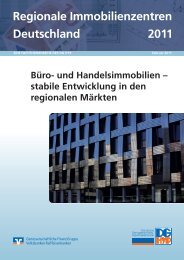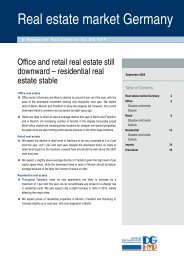ANNUAL REPORT 2006 - DG Hyp
ANNUAL REPORT 2006 - DG Hyp
ANNUAL REPORT 2006 - DG Hyp
You also want an ePaper? Increase the reach of your titles
YUMPU automatically turns print PDFs into web optimized ePapers that Google loves.
Management Report<br />
A system for collecting and recording loss data has<br />
already been in place since 2002. Incoming loss reports are<br />
collected systematically in a database arranged according<br />
to predefined categories: they are subsequently used as<br />
indicators for further improving the operating processes,<br />
and hence for reducing operational risks.<br />
In addition, all of <strong>DG</strong> HYP’s organisational units<br />
have regularly conducted self-assessments since 2004.<br />
Current risks are estimated using a standardised electronic<br />
questionnaire. In addition, Risk Controlling carries out<br />
continuous plausibility and consistency checks.<br />
In order to also be able to identify operational risks in<br />
good time, an early warning system regularly records<br />
various risk indicators (such as system failures, fraud, and<br />
staff fluctuation). The agreed risk indicators and the collated<br />
reports are submitted anonymously within the scope of<br />
group-wide reporting to DZ BANK.<br />
VR Kreditwerk is responsible for credit processing in the<br />
retail business and for the provision of IT services. The<br />
operational risks inherent to <strong>DG</strong> HYP from these activities<br />
are taken into consideration in the systems of VR Kreditwerk<br />
and of <strong>DG</strong> HYP. This knowledge is enhanced by<br />
expertise gained in the controlling of outsourced activities.<br />
The emphasis is on business continuity measures<br />
addressing operational risks that arise from the use of the<br />
bank’s property and of the IT system. The key measures for<br />
dealing with such risks are laid down in the emergency<br />
handbook. From an organisational perspective, <strong>DG</strong> HYP’s<br />
Risk Controlling is responsible for measuring operational<br />
risks. Risk Controlling reports regularly on operational<br />
risk issues to <strong>DG</strong> HYP’s Management Board, and on the<br />
activities for further developing the quantification<br />
approach, within the scope of the Risk/Return Management<br />
Committee meetings.<br />
V) Strategic risks<br />
Strategic risks include the threat of losses arising from<br />
management decisions regarding <strong>DG</strong> HYP’s business policy.<br />
Strategic risks can also include long-term success factors<br />
in <strong>DG</strong> HYP’s environment. These include, for example,<br />
changes to the legal or corporate environment, changes<br />
to the market and competitive conditions, customers or<br />
re-financing parameters. We also include planning and<br />
reputation risks in this risk category.<br />
In order to reduce planning risks, variance analyses are<br />
prepared as a basis for continuously reviewing planning<br />
data and assumptions.<br />
Reputation risk concerns direct or indirect losses<br />
incurred by the erosion of <strong>DG</strong> HYP’s reputation among<br />
shareholders, staff, customers, business partners and the<br />
general public. All activities and events that can affect the<br />
bank’s reputation are identified in both the Corporate<br />
Communications and Strategy organisational units, and<br />
in the market units concerned. They are evaluated in<br />
close cooperation with the Management Board, in order to<br />
mitigate their impact as early as possible.<br />
<strong>DG</strong> HYP generally uses, amongst other things, investment<br />
calculations and projections, business plans including<br />
scenario-based simulations, cost/benefit analyses, and risk<br />
analyses as the basis for strategic decisions, in order<br />
to identify and minimise strategic risks. In addition, all<br />
decision proposals submitted that may involve or induce<br />
strategic risks include a statement by the responsible<br />
organisational unit on the risk content, which is taken into<br />
account in the resolution passed.<br />
Given that, as a rule, strategic risks are subject to very<br />
complex and irregular factual connections, they cannot be<br />
included in an integrated system as special risks. They are<br />
therefore specially monitored by the Management Board;<br />
they are also monitored and continuously analysed by<br />
the respective individual organisational units responsible.<br />
The regular review of business unit strategies is also a<br />
core element of the continuous process of business unit<br />
planning and control.<br />
Deutsche Genossenschafts-<strong>Hyp</strong>othekenbank AG | Annual Report <strong>2006</strong><br />
41














